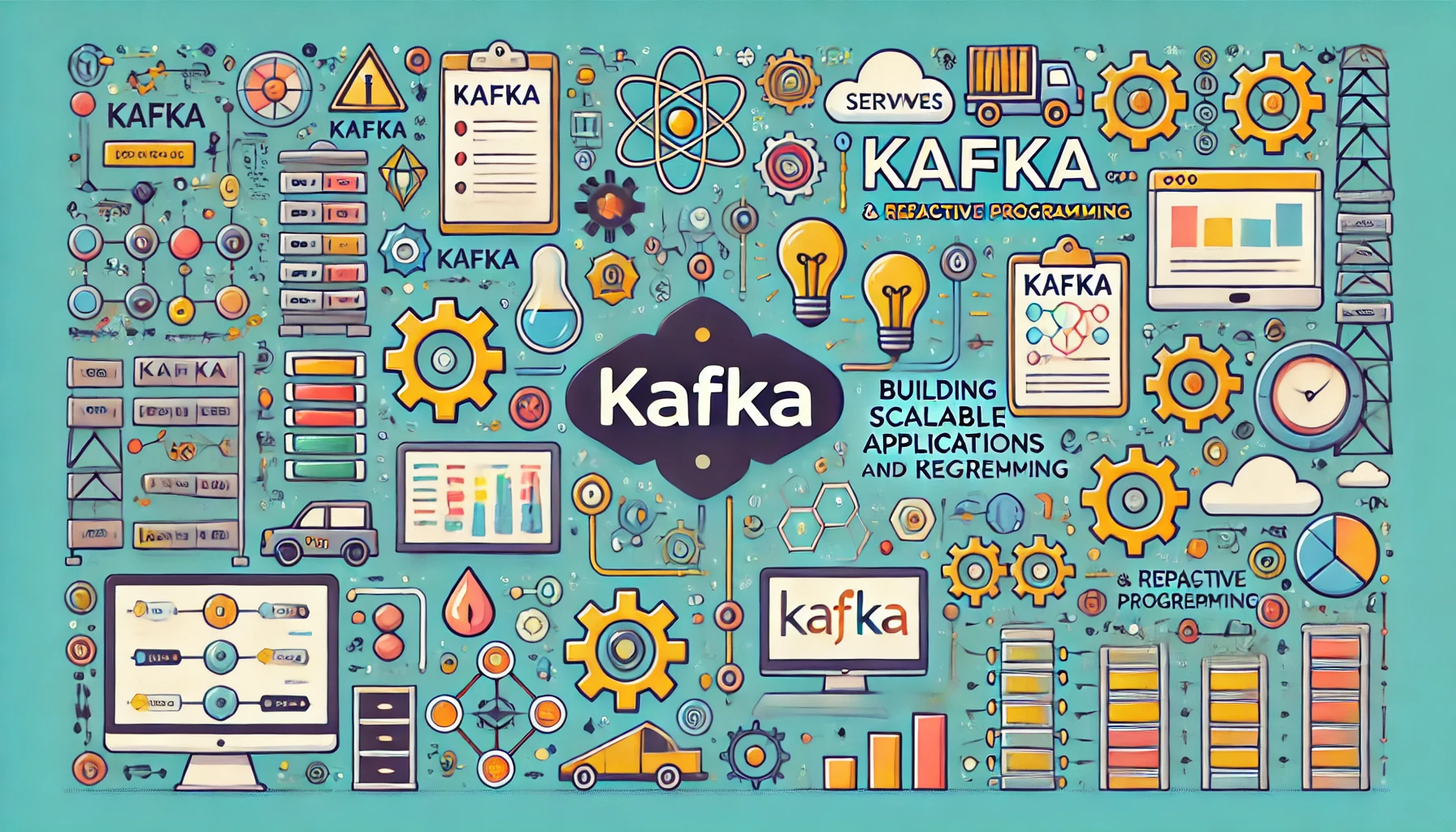Building Scalable Applications with Kafka and Reactive Programming
 Mahidhar Mullapudi
Mahidhar Mullapudi
Introduction
In today's digital world, the ability to process data in real-time and scale applications efficiently is crucial for success. Kafka, a distributed event streaming platform, combined with reactive programming, offers powerful tools to achieve these goals. This article explores how to build scalable applications using Kafka and reactive programming, making these concepts accessible to our readers.
Understanding the Basics
Before diving into the details, let's break down some key concepts.
Kafka: Apache Kafka is a distributed event streaming platform used for building real-time data pipelines and streaming applications. It can handle large volumes of data and process it in real-time. Kafka works by allowing applications to produce and consume streams of records (events or messages).
Reactive Programming: Reactive programming is an approach to software development that focuses on asynchronous data streams and the propagation of changes. It enables applications to be more responsive, resilient, and scalable.
Scalability: Scalability refers to the ability of a system to handle an increasing amount of work or its potential to be enlarged to accommodate that growth. In the context of applications, it means being able to manage more users, data, or transactions without compromising performance.
Real-Time Data Streaming: This involves processing data as it arrives, allowing applications to respond immediately to changes or events. It contrasts with batch processing, where data is collected and processed in chunks at scheduled intervals.
Setting the Stage: Why Kafka and Reactive Programming?
Kafka and reactive programming complement each other well. Kafka provides a robust mechanism for handling data streams, while reactive programming offers a way to process these streams efficiently and responsively. Together, they enable the creation of scalable, real-time applications.
Key Benefits:
High Throughput: Kafka can handle large volumes of data with minimal latency.
Fault Tolerance: Kafka's distributed architecture ensures data is replicated and resilient to failures.
Scalability: Both Kafka and reactive programming are designed to scale horizontally, meaning you can add more nodes to handle increased load.
Asynchronous Processing: Reactive programming's asynchronous nature ensures non-blocking operations, improving responsiveness.
Setting Up Kafka
To start building scalable applications with Kafka, you need to set up a Kafka cluster. A cluster consists of multiple Kafka brokers, each responsible for handling data streams.
Step-by-Step Setup:
Download and Install Kafka:
Go to the Apache Kafka download page and get the latest version.
Extract the downloaded files and navigate to the Kafka directory.
Start Zookeeper:
Kafka relies on Zookeeper, a distributed coordination service. Start Zookeeper using the command:
bin/zookeeper-server-start.sh config/zookeeper.properties
Start Kafka Broker:
Once Zookeeper is running, start a Kafka broker:
bin/kafka-server-start.sh config/server.properties
Create a Topic:
Kafka organizes data into topics. Create a new topic using:
bin/kafka-topics.sh --create --topic my-topic --bootstrap-server localhost:9092 --partitions 1 --replication-factor 1
Produce and Consume Messages:
Produce messages to the topic:
bin/kafka-console-producer.sh --topic my-topic --bootstrap-server localhost:9092Consume messages from the topic:
bin/kafka-console-consumer.sh --topic my-topic --bootstrap-server localhost:9092 --from-beginning
Introduction to Reactive Programming
Reactive Programming Concepts:
Asynchronous: Operations are non-blocking, meaning they don't wait for each other to complete.
Event-Driven: Code reacts to events such as user actions or data changes.
Observable Streams: Data is treated as streams that can be observed and reacted to.
Popular Libraries:
Project Reactor: A reactive programming library for Java, providing a powerful API for composing asynchronous and event-driven applications.
RxJava: Another popular reactive library for Java, inspired by Reactive Extensions.
Simple Reactive Example
Let's look at a basic reactive example using Project Reactor.
import reactor.core.publisher.Flux;
public class ReactiveExample {
public static void main(String[] args) {
Flux<String> dataStream = Flux.just("Hello", "Reactive", "World");
dataStream
.map(String::toUpperCase)
.subscribe(System.out::println);
}
}
In this example, Flux represents a stream of data. The map function transforms each element, and subscribe consumes the data, printing it to the console.
Integrating Kafka with Reactive Programming
To build a scalable application, we need to integrate Kafka with reactive programming. This involves using a reactive Kafka client to produce and consume messages.
Producing Messages to Kafka
Using the reactor-kafka library, we can produce messages to Kafka in a reactive way.
Dependencies: Add the following dependencies to your pom.xml (for Maven):
<dependency>
<groupId>io.projectreactor.kafka</groupId>
<artifactId>reactor-kafka</artifactId>
<version>1.3.5</version>
</dependency>
<dependency>
<groupId>org.apache.kafka</groupId>
<artifactId>kafka-clients</artifactId>
<version>2.7.0</version>
</dependency>
Reactive Kafka Producer:
import org.apache.kafka.clients.producer.ProducerConfig;
import org.apache.kafka.common.serialization.StringSerializer;
import reactor.core.publisher.Flux;
import reactor.kafka.sender.KafkaSender;
import reactor.kafka.sender.SenderOptions;
import reactor.kafka.sender.SenderRecord;
import java.util.HashMap;
import java.util.Map;
public class ReactiveKafkaProducer {
public static void main(String[] args) {
Map<String, Object> props = new HashMap<>();
props.put(ProducerConfig.BOOTSTRAP_SERVERS_CONFIG, "localhost:9092");
props.put(ProducerConfig.KEY_SERIALIZER_CLASS_CONFIG, StringSerializer.class);
props.put(ProducerConfig.VALUE_SERIALIZER_CLASS_CONFIG, StringSerializer.class);
SenderOptions<String, String> senderOptions = SenderOptions.create(props);
KafkaSender<String, String> sender = KafkaSender.create(senderOptions);
Flux<SenderRecord<String, String, String>> outboundFlux = Flux.range(1, 10)
.map(i -> SenderRecord.create(new ProducerRecord<>("my-topic", "key" + i, "value" + i), "correlationId" + i));
sender.send(outboundFlux)
.doOnError(e -> System.err.println("Send failed: " + e))
.doOnNext(r -> System.out.println("Message sent: " + r.correlationMetadata()))
.subscribe();
}
}
This example sets up a Kafka producer with reactive programming. It sends ten messages to the my-topic topic, logging the success or failure of each message.
Consuming Messages from Kafka
Similarly, we can consume messages from Kafka reactively.
Reactive Kafka Consumer:
import org.apache.kafka.clients.consumer.ConsumerConfig;
import org.apache.kafka.common.serialization.StringDeserializer;
import reactor.kafka.receiver.KafkaReceiver;
import reactor.kafka.receiver.ReceiverOptions;
import java.util.Collections;
import java.util.HashMap;
import java.util.Map;
public class ReactiveKafkaConsumer {
public static void main(String[] args) {
Map<String, Object> props = new HashMap<>();
props.put(ConsumerConfig.BOOTSTRAP_SERVERS_CONFIG, "localhost:9092");
props.put(ConsumerConfig.GROUP_ID_CONFIG, "reactive-consumer-group");
props.put(ConsumerConfig.KEY_DESERIALIZER_CLASS_CONFIG, StringDeserializer.class);
props.put(ConsumerConfig.VALUE_DESERIALIZER_CLASS_CONFIG, StringDeserializer.class);
ReceiverOptions<String, String> receiverOptions = ReceiverOptions.create(props)
.subscription(Collections.singleton("my-topic"));
KafkaReceiver<String, String> receiver = KafkaReceiver.create(receiverOptions);
receiver.receive()
.doOnNext(record -> System.out.println("Received message: " + record.value()))
.subscribe();
}
}
In this example, the consumer subscribes to my-topic and prints each received message to the console.
Building a Scalable Application: Use Case Example
To illustrate how Kafka and reactive programming can be used together, let's consider a use case: a real-time monitoring system for a fleet of delivery trucks. The system needs to process and display the location and status of each truck in real-time.
Components of the System
Truck Sensors: Devices installed in trucks that send location and status updates.
Kafka Broker: Collects and streams sensor data.
Reactive Microservices: Processes and analyzes data.
Dashboard Application: Displays real-time data to users.
Step-by-Step Implementation:
- Truck Sensors: Simulate sensors that send data to Kafka.
import org.apache.kafka.clients.producer.ProducerConfig;
import org.apache.kafka.common.serialization.StringSerializer;
import reactor.core.publisher.Flux;
import reactor.kafka.sender.KafkaSender;
import reactor.kafka.sender.SenderOptions;
import reactor.kafka.sender.SenderRecord;
import java.util.HashMap;
import java.util.Map;
import java.util.Random;
public class TruckSensorSimulator {
public static void main(String[] args) {
Map<String, Object> props = new HashMap<>();
props.put(Producer
Config.BOOTSTRAP_SERVERS_CONFIG, "localhost:9092");
props.put(ProducerConfig.KEY_SERIALIZER_CLASS_CONFIG, StringSerializer.class);
props.put(ProducerConfig.VALUE_SERIALIZER_CLASS_CONFIG, StringSerializer.class);
SenderOptions<String, String> senderOptions = SenderOptions.create(props);
KafkaSender<String, String> sender = KafkaSender.create(senderOptions);
Random random = new Random();
Flux<SenderRecord<String, String, String>> sensorDataFlux = Flux.interval(Duration.ofSeconds(1))
.map(tick -> {
String truckId = "truck-" + random.nextInt(10);
String location = "loc-" + random.nextInt(100);
String status = "status-" + random.nextInt(3);
String value = String.format("%s,%s,%s", truckId, location, status);
return SenderRecord.create(new ProducerRecord<>("truck-data", truckId, value), "correlationId" + tick);
});
sender.send(sensorDataFlux)
.doOnError(e -> System.err.println("Send failed: " + e))
.doOnNext(r -> System.out.println("Message sent: " + r.correlationMetadata()))
.subscribe();
}
}
Kafka Broker: Set up and run Kafka as described earlier.
Reactive Microservices: Process data from Kafka and perform real-time analysis.
import org.apache.kafka.clients.consumer.ConsumerConfig;
import org.apache.kafka.common.serialization.StringDeserializer;
import reactor.kafka.receiver.KafkaReceiver;
import reactor.kafka.receiver.ReceiverOptions;
import java.util.Collections;
import java.util.HashMap;
import java.util.Map;
public class TruckDataProcessor {
public static void main(String[] args) {
Map<String, Object> props = new HashMap<>();
props.put(ConsumerConfig.BOOTSTRAP_SERVERS_CONFIG, "localhost:9092");
props.put(ConsumerConfig.GROUP_ID_CONFIG, "truck-data-processor-group");
props.put(ConsumerConfig.KEY_DESERIALIZER_CLASS_CONFIG, StringDeserializer.class);
props.put(ConsumerConfig.VALUE_DESERIALIZER_CLASS_CONFIG, StringDeserializer.class);
ReceiverOptions<String, String> receiverOptions = ReceiverOptions.create(props)
.subscription(Collections.singleton("truck-data"));
KafkaReceiver<String, String> receiver = KafkaReceiver.create(receiverOptions);
receiver.receive()
.doOnNext(record -> {
String[] data = record.value().split(",");
String truckId = data[0];
String location = data[1];
String status = data[2];
// Process and analyze the data (e.g., updating a database or triggering alerts)
System.out.println("Processed data for truck: " + truckId + ", location: " + location + ", status: " + status);
})
.subscribe();
}
}
- Dashboard Application: Display processed data to users in real-time.
For the dashboard application, we can use a web framework like Spring Boot with WebFlux, which supports reactive programming. The dashboard will subscribe to a WebSocket endpoint to receive real-time updates.
Spring Boot WebFlux Setup:
Dependencies: Add the following dependencies to your pom.xml (for Maven):
<dependency>
<groupId>org.springframework.boot</groupId>
<artifactId>spring-boot-starter-webflux</artifactId>
</dependency>
<dependency>
<groupId>org.springframework.boot</groupId>
<artifactId>spring-boot-starter-websocket</artifactId>
</dependency>
<dependency>
<groupId>org.springframework.kafka</groupId>
<artifactId>spring-kafka</artifactId>
</dependency>
<dependency>
<groupId>org.apache.kafka</groupId>
<artifactId>kafka-clients</artifactId>
<version>2.7.0</version>
</dependency>
WebFlux Configuration:
import org.springframework.context.annotation.Configuration;
import org.springframework.web.reactive.config.EnableWebFlux;
import org.springframework.web.reactive.config.WebFluxConfigurer;
@Configuration
@EnableWebFlux
public class WebFluxConfig implements WebFluxConfigurer {
// WebFlux configuration can be added here if needed
}
WebSocket Configuration:
import org.springframework.context.annotation.Configuration;
import org.springframework.web.socket.config.annotation.EnableWebSocket;
import org.springframework.web.socket.config.annotation.WebSocketConfigurer;
import org.springframework.web.socket.config.annotation.WebSocketHandlerRegistry;
@Configuration
@EnableWebSocket
public class WebSocketConfig implements WebSocketConfigurer {
@Override
public void registerWebSocketHandlers(WebSocketHandlerRegistry registry) {
registry.addHandler(new TruckDataWebSocketHandler(), "/truck-data").setAllowedOrigins("*");
}
}
WebSocket Handler:
import org.springframework.web.reactive.socket.WebSocketHandler;
import org.springframework.web.reactive.socket.WebSocketSession;
import org.springframework.web.reactive.socket.server.support.WebSocketHandlerAdapter;
import reactor.core.publisher.Mono;
public class TruckDataWebSocketHandler extends WebSocketHandlerAdapter implements WebSocketHandler {
@Override
public Mono<Void> handle(WebSocketSession session) {
// Simulate sending real-time updates to the client
return session.send(
session.receive()
.map(msg -> session.textMessage("Received: " + msg.getPayloadAsText()))
.doOnError(e -> System.err.println("WebSocket error: " + e))
);
}
}
Reactive Kafka Consumer Service:
import org.apache.kafka.clients.consumer.ConsumerConfig;
import org.apache.kafka.common.serialization.StringDeserializer;
import org.springframework.kafka.annotation.KafkaListener;
import org.springframework.kafka.core.ConsumerFactory;
import org.springframework.kafka.core.DefaultKafkaConsumerFactory;
import org.springframework.kafka.listener.ConcurrentMessageListenerContainer;
import org.springframework.kafka.listener.config.ContainerProperties;
import org.springframework.stereotype.Service;
import reactor.core.publisher.Flux;
import reactor.core.publisher.Sinks;
import java.util.HashMap;
import java.util.Map;
@Service
public class TruckDataService {
private final Sinks.Many<String> sink = Sinks.many().multicast().onBackpressureBuffer();
@KafkaListener(topics = "truck-data", groupId = "truck-data-processor-group")
public void listen(String message) {
sink.tryEmitNext(message);
}
public Flux<String> getTruckDataStream() {
return sink.asFlux();
}
public ConsumerFactory<String, String> consumerFactory() {
Map<String, Object> props = new HashMap<>();
props.put(ConsumerConfig.BOOTSTRAP_SERVERS_CONFIG, "localhost:9092");
props.put(ConsumerConfig.GROUP_ID_CONFIG, "truck-data-processor-group");
props.put(ConsumerConfig.KEY_DESERIALIZER_CLASS_CONFIG, StringDeserializer.class);
props.put(ConsumerConfig.VALUE_DESERIALIZER_CLASS_CONFIG, StringDeserializer.class);
return new DefaultKafkaConsumerFactory<>(props);
}
public ConcurrentMessageListenerContainer<String, String> kafkaListenerContainer() {
ContainerProperties containerProps = new ContainerProperties("truck-data");
return new ConcurrentMessageListenerContainer<>(consumerFactory(), containerProps);
}
}
REST Controller:
import org.springframework.beans.factory.annotation.Autowired;
import org.springframework.web.bind.annotation.GetMapping;
import org.springframework.web.bind.annotation.RestController;
import reactor.core.publisher.Flux;
@RestController
public class TruckDataController {
@Autowired
private TruckDataService truckDataService;
@GetMapping("/truck-data")
public Flux<String> getTruckData() {
return truckDataService.getTruckDataStream();
}
}
This setup streams real-time truck data to a WebSocket endpoint, where the dashboard application can connect and display updates.
Conclusion
By combining Kafka and reactive programming, we can build highly scalable applications capable of processing and responding to real-time data streams. Kafka provides a robust mechanism for handling large volumes of data, while reactive programming ensures that applications remain responsive, resilient, and efficient.
This article has walked you through setting up Kafka, understanding reactive programming, and integrating the two to create a real-time monitoring system. Whether you're building applications for monitoring, data processing, or other real-time requirements, Kafka and reactive programming offer powerful tools to help you succeed.
Subscribe to my newsletter
Read articles from Mahidhar Mullapudi directly inside your inbox. Subscribe to the newsletter, and don't miss out.
Written by

Mahidhar Mullapudi
Mahidhar Mullapudi
Currently working as Senior Staff Engineer @Microsoft, I'm an expert in software architecture, system design, architectural patterns of a large-scale distributed products/services, cloud infrastructure and security. Proficient in different programming languages including Java, C#, Python with over a decade of experience working on applications at scale. Independent researcher with more than 20+ research articles across different fields in Computer Science with focus on Distributed systems, designing and building large-scale resilient applications, building real-time data platforms for analytics and Machine Learning. Founder and author of tutorialQ (https://tutorialq.com/) which provides quality technical content for learning programming, web development and other software related tech stack.